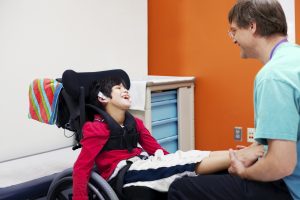
A considerable overlap was seen among all the conditions. Seventeen percent of autistic children also had ADHD, over 11 percent of autists had epilepsy, and nearly 13 percent of epileptic children had cerebral palsy.
Lead investigator Pål Surén wrote, “The findings demonstrate the significant burden of disease associated with neurologic and neurodevelopmental disorders in children, and that this burden is disproportionately skewed towards boys.”
The researchers only examined data from 2008 to 2010, and suggest that prevalence may be higher if they would examine the data previous to 2008.
The researchers wrote, “Validation studies of these diagnoses would strengthen the research value of NPR [Norwegian Patient Register] data and will be undertaken in the years to come.”
The findings were published in Pediatrics.
Autism more common in cerebral palsy children
An alternative study found that autism is more common in children with cerebral palsy. Children with cerebral palsy were screened by the Autism and Developmental Disabilities Monitoring (ADDM) Network, which is a cerebral palsy monitoring system within four parts of the U.S. Autism prevalence among cerebral palsy children was determined among eight-year-olds in 2008.
Prevalence of cerebral palsy at the time was found to be 3.1 per 1,000 eight-year-olds. Nearly 58 percent of children could walk properly, as measured by Gross Motor Function Classification System level and walking ability. Co-occurring autism was 6.9 percent and much more frequent, compared to children with non-spastic cerebral palsy.
The study noted that prevalence of autism in cerebral palsy children has remained constant since 1996, and that the higher prevalence of autism in non-spastic cerebral palsy requires further investigation.
Relationship between cerebral palsy and attention-deficit hyperactivity disorder (ADHD)
When ADHD is paired with cerebral palsy, it can lead to greater challenges and complications. Cerebral palsy symptoms typically occur at a much younger age than ADHD, thus delaying the diagnosis.
ADHD becomes more challenging to diagnose when a child has a coexisting health condition that may mask ADHD. Additionally, symptom patterns must remain consistent in order to properly diagnose ADHD. These symptoms include displaying inattention to details, making mistakes in homework, having trouble focusing on play activities, not listening when spoken to, not doing homework correctly or completely, having trouble organizing their time, avoiding strenuous mental activity, losing things in a consistent manner, being very distracted, and being forgetful in small activities.
In order to better diagnose ADHD in a child with cerebral palsy, a doctor must perform a thorough examination, and monitoring of ADHD symptoms must be done.
Related Reading:
ADHD, autism similarities to be revealed by research to develop effective behavioral therapies
More research seems to suggest a link between ADHD and autism that could lead to the development of useful behavioral therapy treatments. Jean Gehricke is a well-known associate professor of pediatrics at University of California, Irvine, and he’s a clinical psychologist with the Center for Autism and Neurodevelopmental Disorders. Right now, a great deal of his work focuses on gaining a better understanding of why people with ADHD and autism seem to be more prone to substance abuse. Continue reading…
ADHD tied to higher eating disorders risk
Attention deficit hyperactivity disorder (ADHD) is tied to a higher risk of eating disorders. Attention deficit hyperactivity disorder is a condition that commonly affects children and can stay with a person right into adulthood. The disorder is characterized by an inability to focus or pay attention, difficulty controlling behavior, and hyperactivity. Continue reading…
Sources:
http://www.cerebralpalsysource.com/About_CP/add-cp/index.html
http://onlinelibrary.wiley.com/enhanced/doi/10.1111/dmcn.12268/
http://www.medscape.com/viewarticle/765995